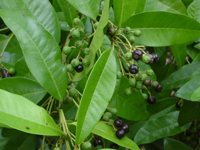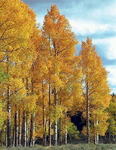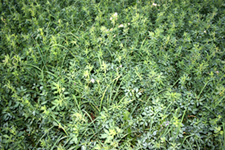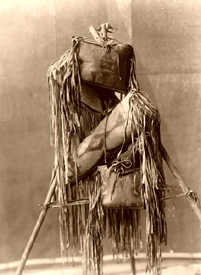NATIVE AMERICAN MEDICINES
HERBS AND PLANTS
| ||
Allspice - Formally known as Pimenta Dioica, this fragrant spice is not only used in cooking and seasoning, but also as an herbal remedy. Also known as Jamaica Pepper, Kurundu, Myrtle Pepper, Pimenta, Clove Pepper, and Newspice, it owes its healing powers to "eugenol," a chemical component in its oil that aids digestion and is an effective pain reliever. It's dried unripe berries have long been used in teas for treatment of colds, menstrual cramps, upset stomach, indigestion, flatulence, diabetes, toothaches, and relief of muscle aches and pains. The berries have also been crushed and made into poultices and salves and applied directly to bruises, sore joints, aching muscles. American Licorice - Officially known as Glycyrrhiza Lepidota, and sometimes called wild licorice, it is native to most of North America, from central Canada south through the United States to California, Texas and Virginia, but absent from the southeastern states. Its roots have been widely used by a number of Native American tribes in teas for the treatment of cough,diarrhea, chest pain, fever, stomach aches, and to speed the delivery of the placenta after childbirth. It is also used as a wash or poultice on swelling . The chewed root is retained in the mouth as a treatment for toothache and sore throats. The mashed leaves are used as a poultice on sores.  American Mistletoe - Specifically known as Phoradendron Leucarpum, this is a species of mistletoe which is native to the United States and Mexico. Its common names include Eastern Mistletoe, Hairy Mistletoe, Oak Mistletoe, Pacific Mistletoe, or Western Mistletoe. Druids in Europe used another species of mistletoe some 1,500 years ago for convulsions, delirium, hysteria, neuralgia, and heart conditions. Native Americans used Phoradendron in similar ways for blood pressure, lung problems, epilepsy, headache, abortions and as a contraceptive. The Cherokee made a tea ooze that was used to bathe the head for headache and the Creek made a concoction for lung troubles, such as tuberculosis. The Mendocino Indians often used the root to induce abortions and to prevent conception. Other uses included chewing on the root for toothaches, rubbing the body with a decoction of leave for painful limbs and joints. It was also used by some tribes in religious ceremonies. The plant is considered as poisoness and should be used with caution. American Mistletoe - Specifically known as Phoradendron Leucarpum, this is a species of mistletoe which is native to the United States and Mexico. Its common names include Eastern Mistletoe, Hairy Mistletoe, Oak Mistletoe, Pacific Mistletoe, or Western Mistletoe. Druids in Europe used another species of mistletoe some 1,500 years ago for convulsions, delirium, hysteria, neuralgia, and heart conditions. Native Americans used Phoradendron in similar ways for blood pressure, lung problems, epilepsy, headache, abortions and as a contraceptive. The Cherokee made a tea ooze that was used to bathe the head for headache and the Creek made a concoction for lung troubles, such as tuberculosis. The Mendocino Indians often used the root to induce abortions and to prevent conception. Other uses included chewing on the root for toothaches, rubbing the body with a decoction of leave for painful limbs and joints. It was also used by some tribes in religious ceremonies. The plant is considered as poisoness and should be used with caution.Antelope Sage - Formally known as Eriogonum Jamesii, this herb is a species of wild buckwheat also known as James' Buckwheat. Native to southwestern North America, in Colorado, Utah, Arizona, Texas, New Mexico, Oklahoma, and Nebraska; it was often used as a contraceptive by Native Americans, such as the Navajo. The women would drink one cup of a decoction of the root during menstruation. A decoction of the whole plant has also been used to ease the painof childbirth, and the root was chewed or used in teas as a cardiac medicine, for stomach aches, and depression. Some made a wash that was used for sore eyes. Arnica - A member of the sunflower family, one species, called Arnica Montana, has been used for centuries by both Europeans and Native Americans as a topical cream or ointment to soothe muscle aches, reduce inflammation, treat sprains and bruises, and heal wounds. Arnica should not be taken internally as it has caused severe and even fatal poisoning. Ashwagandha - Formally known as Withania Somnifera, it is also called Indian Ginseng, Winter Cherry, Ajagandha, Kanaje Hindi, Amukkara, and Samm, it is native to the country of India and has a long list of medicinal problems it is used for. Ashwagandha is one of the most widespread tranquillizers used in India, where it holds a position of importance similar to ginseng in China. It acts mainly on the reproductive and nervous systems, having a rejuvenate effect on the body, and is used to improve vitality and aid recovery after chronic illness. The whole plant, especially the leaves and the root bark, are used as an antibiotic, aphrodisiac, diuretic, narcotic, and sedative. It is used to treat post-partum difficulties, nervous exhaustion, insomnia, impotence, infertility, multiple sclerosis, chronic fatigue, dehydration, bone weakness, muscle weakness and tension, loose teeth, constipation, senility, memory loss, and rheumatism. Externally it has been applied as a poultice to boils, swelling and other painful areas. Caution is advised in the use of this plant since it is toxic.  Aspen - Aspen trees are native to cold regions with cool summers. In North America, this includes the far north portions and extending south at high altitudes in the mountains. There are several varieties of Aspen trees, one of which -- the Quaking Aspen, which was used by both Native Americans and early pioneers to treat fever, scurvy, cough, pain, and as an anti-inflammatory. The inner bark of this tree contains salicin, a substance similar to the active ingredient in aspirin. Aspen - Aspen trees are native to cold regions with cool summers. In North America, this includes the far north portions and extending south at high altitudes in the mountains. There are several varieties of Aspen trees, one of which -- the Quaking Aspen, which was used by both Native Americans and early pioneers to treat fever, scurvy, cough, pain, and as an anti-inflammatory. The inner bark of this tree contains salicin, a substance similar to the active ingredient in aspirin.Astragalus - A large genus of about 3,000 species of herbs and small shrubs, it is native to temperate regions of the Northern Hemisphere. Common names include milk-vetch (most species), locoweed (some species in the western U.S.), and goat's-thorn. Used in both traditional Chinese and Native American remedies, the dried roots was often in combination with other herbs, to strengthen the body against disease. Traditional medicinal uses included the treatment of colds, flu, infection, allergies, asthma, fatigue, anemia, wounds, heart and kidney disease, hepatitus, stomach ulcers, and digestive disorders. It is also thought to help protect the body from diseases such as cancer and diabetes and is also used to protect and support the immune system, for preventingcolds, upper respiratory infections, lower blood pressure, treat diabetes, and to protect the liver. Atractylodes - Long used in Traditional Chinese Medicine, this herb is used for indigestion, stomachache, bloating, fluid retention, diarrhea, loss of appetite, weight loss, allergies, and rheumatism. It is used with other herbs for treating lung cancer, and kidney problems. | ||
Cherokee Medicine
Like numerous other Native American tribes, the knowledge of Cherokee medicine was handed down from generation to generation to the "chosen" healers. Traditional Cherokee members consulted their medicine people for not only medical problems, but also dilemmas in their lives, and emotional problems. Like other Native American tribes, their most frequently used remedies were for common colds, aches and pains.
Like numerous other Native American tribes, the knowledge of Cherokee medicine was handed down from generation to generation to the "chosen" healers. Traditional Cherokee members consulted their medicine people for not only medical problems, but also dilemmas in their lives, and emotional problems. Like other Native American tribes, their most frequently used remedies were for common colds, aches and pains.
Some common herbs used by the Cherokee as well as other Native American tribes was boneset tea, as a remedy for colds, while wild cherry bark was used for coughs, sore throat, and diarrhea. To ease the pain during childbirth and speed the delivery process, Blue Cohosh root, was used in a tea. Using Wild Carrot Blossoms and Devil's Club could offset the ill effects of Diabetes. Fevers were soothed with teas made from Dogwood, Feverwort, and Willow bark. A still famously enjoyed Pennyroyal tea was thought to cure headaches, and they used Native Hemlock to help with the flu.
Some serious surgeries that required sedatives would usually be prepared with Wild Lettuce, Hops, and Wild Black Cherry. Heart and circulatory problems were addressed using Green Hellebore, American Hemp, and Dogbane. Many of these Native American remedies were the basis for the modern medicines that are commonly used today such as penicillin.
Some serious surgeries that required sedatives would usually be prepared with Wild Lettuce, Hops, and Wild Black Cherry. Heart and circulatory problems were addressed using Green Hellebore, American Hemp, and Dogbane. Many of these Native American remedies were the basis for the modern medicines that are commonly used today such as penicillin.
** Note: The information above is courtesy of the Cherokee Nation Cultural Resource Center who cautions that it must be remembered that these plants are very valuable as medicines because of the great chemical powers they contain. At the same time, these chemicals can be potentially dangerous if used in the wrong way. Cherokee herbalists have great experience, and have gone through extensive training and observation.
|



No comments:
Post a Comment